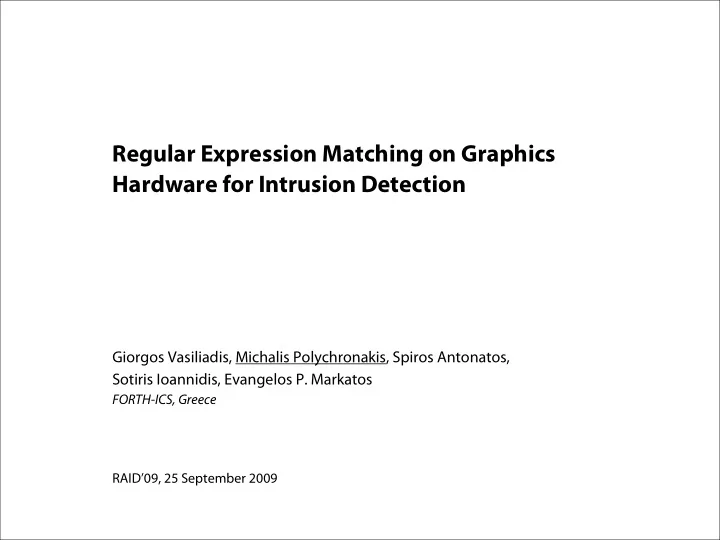

Regular Expression Matching on Graphics Hardware for Intrusion Detection Giorgos Vasiliadis, Michalis Polychronakis, Spiros Antonatos, Sotiris Ioannidis, Evangelos P. Markatos FORTH-ICS, Greece RAID’09, 25 September 2009 mikepo@ics.forth.gr 1
Overview � Increase the processing throughput of network intrusion detection systems (NIDS) � Offload pattern matching operations to the GPU � previous works: string searching � this work: Regular expression matching mikepo@ics.forth.gr 2
Outline � Introduction � Regexp matching on the GPU � Performance evaluation � Summary mikepo@ics.forth.gr 3
Motivation � Pattern matching accounts for up to 80% of the total CPU processing time in modern NIDS � Graphics Cards Easy to program � Powerful and ubiquitous � Vendors have started promoting GPUs as � general-purpose computational units � Why not using the spare cycles of the GPU to speed up NIDS operations? String searching on the GPU [Jacob ’06, Goyal ’08, Vasiliadis ’08] � mikepo@ics.forth.gr 4
Regular Expressions � Much more flexible and expressive compared to string signatures � 45% of the rules in Snort v2.6 use regular expressions alert tcp $EXTERNAL_NET any ‐ > $HOME_NET 10202:10203 (msg:"CA license GCR overflow attempt"; flow:to_server,established; content:"GCR NETWORK<"; depth:12; offset:3; nocase; pcre:"/^\S{65}|\S+\s+\S{65}|\S+\s+\S+\s+\S{65}/Ri"; sid:3520;) � Regular expression matching is much more expensive in terms of CPU cycles than string searching Perfect for off-loading to the GPU mikepo@ics.forth.gr 5
Regular Expressions in Snort Each expression is compiled into a separate automaton � Implemented using the PCRE library � String searching pre-filtering to skip regex matching in the common case � alert tcp any any ‐ > any 80 (content:"<OBJECT"; nocase; pcre:"/<OBJECT\s+[^>]*type\s*=[\x22\x27]\x2f{32}/smi";) mikepo@ics.forth.gr 6
Regular Expression Implementations � NFA (Non-deterministic Finite Automata) for a given state and input byte, there may be several possible next states � Compact representation � Greedy or lazy matching, back-references (backtracking) � Searching can be exponentially slow (backtracking) � DFA (Deterministic Finite Automata) for a given state and input byte, there is only one next state � Can consume an exponentially large amount of memory � Greedy matching only (no backtracking) � Searching is fast – O(N) (no backtracking) mikepo@ics.forth.gr 7
Regular Expression Matching on the GPU � GPU operates in a SPMD fashion Ideal for creating multiple instances of finite state machines � � Regexps are compiled to DFAs at start-up Run on different stream processors, operate on different data � mikepo@ics.forth.gr 8
Transferring Packets to the GPU � Packets are transferred to the GPU in batches � Copies are performed using DMA, without occupying the CPU � Double-buffering allows for computation and communication to overlap mikepo@ics.forth.gr 9
GeForce 9800 GX2 with 128 stream processors mikepo@ics.forth.gr 10
Handling Reassembled TCP streams � Need to match patterns that span multiple packets 64K pseudo-packets � � Split into MTU-sized packets in consecutive rows in the buffer � A thread continues searching in following rows until a final or fail state is reached mikepo@ics.forth.gr 11
DFAs: Number of States 97% of Snort’s regexps have less that 5000 states 11,775 regexps in Snort v2.6 � mikepo@ics.forth.gr 12
DFAs: GPU Memory Requirements 97% of the DFAs fit in less than 200 MB The rest 3% is matched on the CPU using NFAs � mikepo@ics.forth.gr 13
CPU � GPU Packet Transfer Throughput Virtual Memory Page-locked Memory � Use page-locked memory to store incoming packets � DMA allows for higher transfer throughput mikepo@ics.forth.gr 14
GPU Raw Processing Troughput 16Gbit/s (48x CPU) Storing the state machines tables into texture memory achieves better � performance (due to caching) The cost of transferring the packets to the GPU space is not included � mikepo@ics.forth.gr 15
Snort Processing Throughput LLI trace performance is reduced due to extensive TCP stream reassembly � The single-threaded design of Snort forces us to use only one PCB (half of the � card’s computing power) mikepo@ics.forth.gr 16
Snort Processing Throughput (Pure Regex) Web-traffic only, removed all “content:” operators � Each packet is checked against all regexps � mikepo@ics.forth.gr 17
Summary � Regex matching on the GPU is practical… � …and fast! � 16Gbit/s raw throughput (48x CPU) � up to 800Mbit/s (8x CPU) when applied in Snort � Future work � Multiple threads/Snort instances (utilize both PCBs) � Alternative implementations (single/few DFAs, xFAs, speculation – next presentation) � Multiple graphics cards (lots of space in the box) mikepo@ics.forth.gr 18
Regular Expression Matching on Graphics Hardware for Intrusion Detection thank you! Giorgos Vasiliadis, gvasil@csd.uoc.gr Michalis Polychronakis, mikepo@ics.forth.gr Spiros Antonatos, antonat@ics.forth.gr Sotiris Ioannidis, sotiris@ics.forth.gr Evangelos Markatos, markatos@ics.forth.gr mikepo@ics.forth.gr 19
Recommend
More recommend